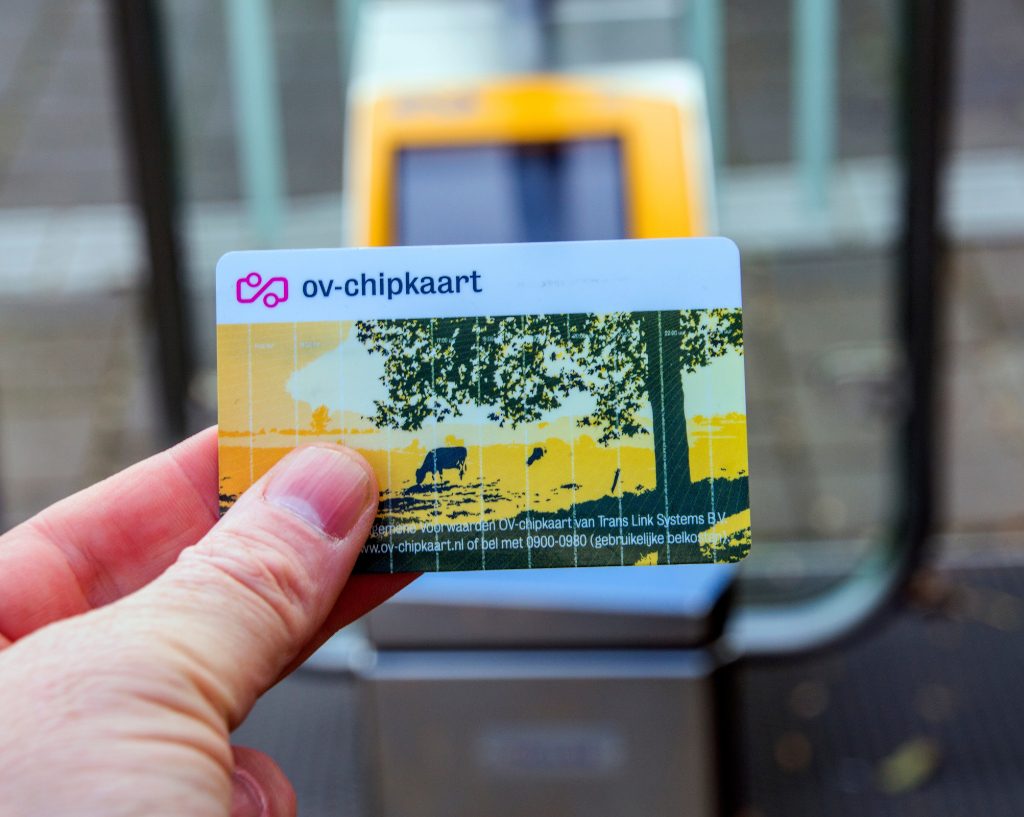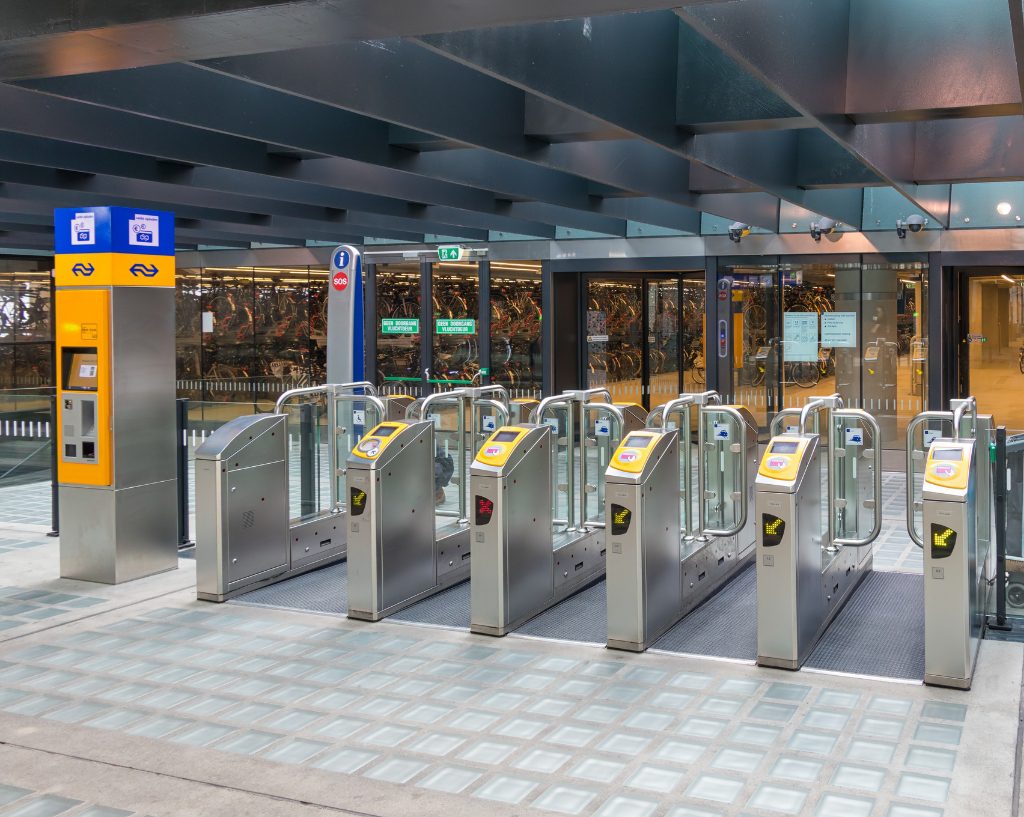PUBLIC TRANSPORT IN THE NETHERLANDS & THE OV-CHIPKAART
The Netherlands is famous for having a really good and easy-to-use transportation system, which is great for people who are new to the country. This guide will show you how to use public transportation in the Netherlands and will explain what an OV-chipkaart is and how to use it.
WHAT IS AN OV-CHIPKAART?
WHAT IS AN OV-CHIPKAART?
OV-CHIPKAART?
An OV-chipkaart is a contactless card used on various forms of public transportation in the Netherlands. It serves as a ticket that passengers can use to travel on trains, buses, trams, and metro services throughout the country. The term “OV” stands for “Openbaar Vervoer,” which translates to “Public transport” in English.
The OV-chipkaart system allows passengers to check in and check out of their chosen mode of transportation by holding the card close to a card reader. The fare for the journey is automatically deducted from the card’s balance. This system makes using public transportation easy and eliminates the need for separate tickets for each journey.

TYPES OF OV-CHIPKAART
TYPES OF OV-CHIPKAART
OV-CHIPKAART
There are 2 types of OV-chipkaart, anonymous and personal. The anonymous OV-chipkaart doesn’t have your personal details on it. It’s like a blank card that you can load money onto and use for public transport. It’s convenient if you don’t want to share your personal information or if you’re just visiting the country temporarily. You can buy this card at vending machines and use it right away by putting money on it.
Another option is getting your own personalized OV-chipkaart. It costs €7.50, and it’s valid for five years. If your card is expired, lost, or broken, you can replace it online and transfer your passes and travel stuff to the new card.
The Personal OV-chipkaart has your name and photo on it. It’s linked to you, and you can add travel subscriptions, discounts, and other benefits to it. This is a good choice if you’re planning to live in the Netherlands for a while and want to use public transport regularly. You usually need to order this card online, and it takes about 5 working days to receive it.
Here’s what you need:
- A photo in jpg format (under 5 MB)
- iDEAL or a Paypal account for payment.
RECHARGE YOUR OV-CHIPKAART
OV-CHIPKAART

To add money to your OV-chipkaart, there are several options available. You can do it online by logging into the OV-chipkaart website and using your bank account or credit card.
Alternatively, most train stations, metro stations, and some tram and bus stops have ticket machines where you can follow the on-screen instructions to add money to your card.
If you prefer in-person assistance, many convenience stores, supermarkets, and tobacco shops have service desks that allow you to add money to your OV-chipkaart. At larger train stations, there are NS service desks (Nederlandse Spoorwegen, or Dutch railways) where you can also add money to to your card.
It’s important to note that you must maintain a minimum amount of credit on your card in order to check in and travel. Keeping an eye on your card’s balance will help you avoid any surprises during your journeys.
PLANNING YOUR JOURNEY
Before you start your trip using buses or trains, it’s a good idea to plan your journey. You can do this using websites or apps on your phone. For example, websites like 9292.nl and NS.nl give you live updates about when your transport will leave, how to switch between different ones, and where you need to wait.
These tools are super useful, especially if you’re new here and still getting used to where the buses and trains go and when they leave. So, before you head out, take a look at these websites to make your trip smoother!
CHECK-IN AND CHECK-OUT
When you use the OV-chipkaart, you have to do two things: check in and check out. This is important for paying the right fare. Here’s how:
- Check In: at the beginning of your trip, find the card readers. They’re at train stations, on trams, buses, and by ferry docks. Hold your card close to the reader. This tells the system you’re starting your journey.
- Check Out: when you’re done with your trip, do the same thing again. Look for the card reader and touch your card to it. This way, the system knows you’re done traveling.
DIDN’T CHECK OUT?
When you check in and out, you make sure that you are charged the correct amount for your ride. It can happen that you forget to check out and you might end up paying more than you should have. This is because the system assumes you traveled the maximum distance possible for the chosen mode of transport.
In case you realize that you didn’t check out, there is a refund process you can follow. You need to contact the customer service or fill in the online refund form here.
If you keep forgetting to check out, there could be more problems. Your card might stop working for a bit to make sure nobody else uses it wrongly.
So, always remember to check out when you finish your ride. It’s like the final step to make sure you don’t pay too much or have to deal with blocked cards or waiting for refunds. Just a simple move that can save you money and trouble.

BIKES & PUBLIC TRANSPORT
In the Netherlands, lots of people love riding bicycles, and as someone new to the country, you might discover that biking is a great friend to public transportation. At many train stations, they have special places just for parking bikes. This makes it easy for you to use your bike in combination with the train.
Biking is cool because it gives you flexibility. You can go where you want, when you want. Plus, it lets you check out the places around you in a nice, relaxed way. So, think about hopping on a bike – it could be a fun way to move around!
You can even take your bicycle on Dutch trains, but there are some rules and costs involved. Here’s what you need to know:
Cost: taking your bicycle on a train usually requires an additional ticket. This ticket is called a “fietskaart,” which means bicycle ticket. The cost varies depending on the distance you’re traveling. It’s a good idea to check the current prices on the official Dutch railways (NS) website.
Off-peak hours: bicycles are allowed on trains during off-peak hours on weekdays (before 6:30, between 9:00 – 16:00 and between 18:30 – 6:30. However, there might be some exceptions during holidays or special events.
Train types: not all trains allow bicycles. Intercity trains generally have space for bikes, but some regional trains might not. It’s a good idea to check the specific train’s details before you travel.
Foldable bikes: small, foldable bicycles can be taken on trains for free, as long as they’re folded and packed in a carrying bag.
Bike storage: when you bring your bike on the train, you need to store it in designated areas. Trains have special sections for bicycles, usually located near the doors.
Local rules: sometimes, local rules might apply, so always check with the specific train company or on the NS website for the most up-to-date information and guidelines.

CONCLUSION
Using public transportation in the Netherlands isn’t just a way to get from one place to another – it’s also a chance to see how the locals live. Imagine enjoying a cup of coffee while riding on a train or looking out the tram window at the beautiful views passing by. Each trip you take becomes a part of your exciting expat journey.
Getting the hang of using public transport as an expat in the Netherlands is like getting a ticket to explore the country in a smart and real way. When you know how the OV-chipkaart works, plan your trips, and embrace all the different types of transportation, you’ll be moving around like a real Dutch person before you know it. So, get ready to jump on board – let the Dutch public transport system show you all the wonderful things this country has to offer!
Looking for a job in the Netherlands? Have a look at our available jobs and apply below.

